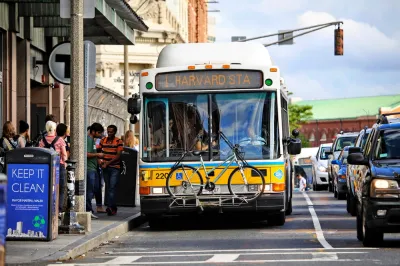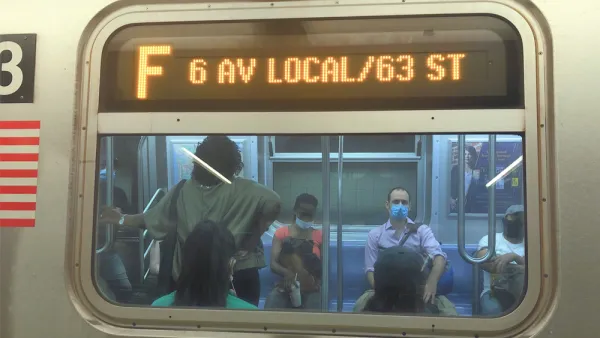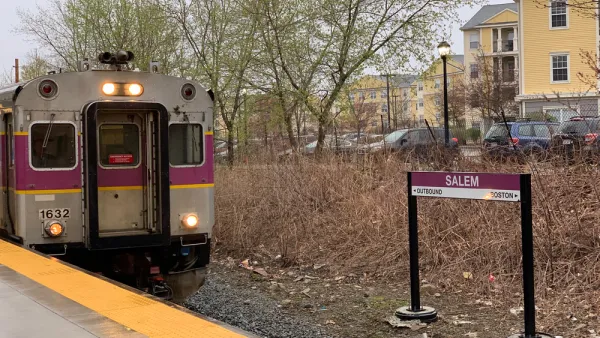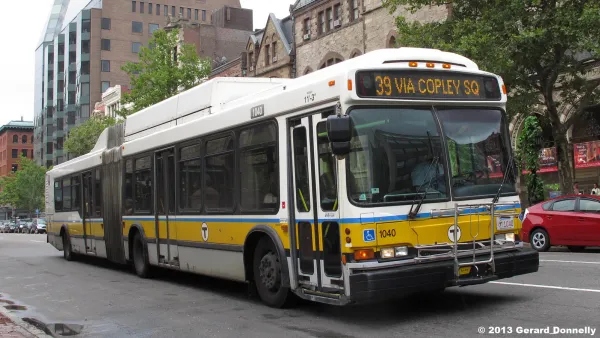The Massachusetts Bay Transportation Authority (MBTA) this week proposed cuts to public transit service. In a decision that will likely repeat as more transit agencies undertake similar processes, the MBTA decided to prioritize buses over trains.

The Massachusetts Bay Transportation Authority (MBTA) announced this week proposed service cuts to weekend commuter rail, 25 bus routes, all the ferry services in the system, and late-night subway service as the fiscal impact of the pandemic and declining fare revenues continue to take a toll on the transit system in the Boston region.
Steve LeBlanc breaks the news of the proposed cuts for the Associated Press, noting that ridership on all MBTA services is down to 330,000 average work day trips—down from 1.26 million average daily trips before the pandemic. The MBTA has yet to reduce service, but officials say the status quo can't last.
A separate article by Nik DeCosta-Klipa provides additional coverage of the MBTA's proposed service cuts, noted the huge number of uncertainties facing public transit, eight months into the pandemic in the United States: "How long will the COVID-19 pandemic endure? When will ridership return to its pre-coronavirus levels? Will ridership return to its pre-coronavirus levels?"
The answer MBTA planners have arrived on in producing the proposed service cuts: service with the lowest number of riders, as proven by persistent ridership during the pandemic, will see the deepest cuts.
Another article on the subject by Dan Zukowski picks up on the consequences of that decision: post-pandemic transit planning is likely to place priority on buses instead of commuter rail lines.
"As transit agencies plot their recovery from the devastating effects of the 2020 pandemic, a common denominator is emerging: more riders need city buses than suburban trains," writes Zukowski.
The story is the same in metro area after metro area, according to Zukowski: buses are carrying a far larger share of pre-Covid ridership levels (41 percent in Boston, 50 percent in New York, and 50 percent in Los Angeles) than commuter rail lines (12 percent in Boston, 16 percent in New York, and 10 percent in Los Angeles).
These ridership trends are likely to linger well into the future, according to Zukowski, as companies shift toward work from home arrangements even after the pandemic is over. The MBTA could just be the first in a wave of diminishing planning and funding priority for commuter rail.
"Planners are categorizing each subway, light rail, commuter and bus line along a four-axis grid that will determine the shape of Boston’s future transit system," according to Zukowski. "Most routes with high ridership serving transit-dependent customers will maintain existing service, and some may see increased service. Routes on the other end of the spectrum — with low ridership and less rider dependency on transit — are most likely to lose service. For other lines, the budget available to keep them running will determine future service levels." (DeCosta-Klipa provided a similar description of the evaluation process leading to the MBTA's service reduction proposal.)
Kat Benesh, chief of operations strategy, policy, and oversight for the MBTA, is quoted Zukowski's article saying that service changes made as a result of this process will be permanent.
FULL STORY: Transit agencies rethink future of commuter rail

National Parks Layoffs Will Cause Communities to Lose Billions
Thousands of essential park workers were laid off this week, just before the busy spring break season.

Retro-silient?: America’s First “Eco-burb,” The Woodlands Turns 50
A master-planned community north of Houston offers lessons on green infrastructure and resilient design, but falls short of its founder’s lofty affordability and walkability goals.

Delivering for America Plan Will Downgrade Mail Service in at Least 49.5 Percent of Zip Codes
Republican and Democrat lawmakers criticize the plan for its disproportionate negative impact on rural communities.

Test News Post 1
This is a summary

Test News Headline 46
Test for the image on the front page.

Balancing Bombs and Butterflies: How the National Guard Protects a Rare Species
The National Guard at Fort Indiantown Gap uses GIS technology and land management strategies to balance military training with conservation efforts, ensuring the survival of the rare eastern regal fritillary butterfly.
Urban Design for Planners 1: Software Tools
This six-course series explores essential urban design concepts using open source software and equips planners with the tools they need to participate fully in the urban design process.
Planning for Universal Design
Learn the tools for implementing Universal Design in planning regulations.
EMC Planning Group, Inc.
Planetizen
Planetizen
Mpact (formerly Rail~Volution)
Great Falls Development Authority, Inc.
HUDs Office of Policy Development and Research
NYU Wagner Graduate School of Public Service





























